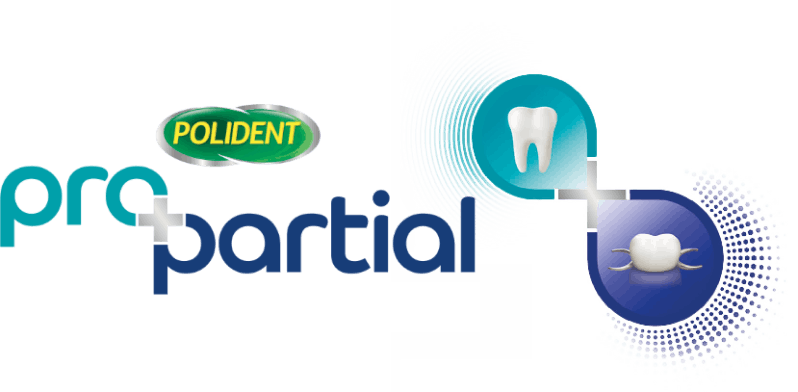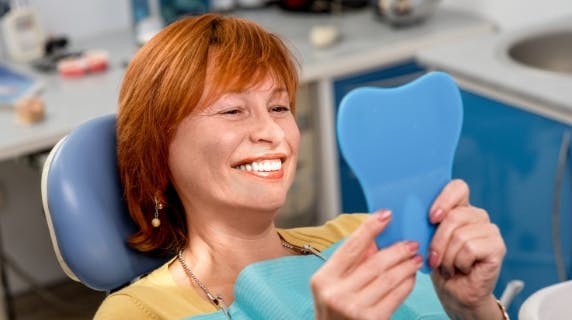
Learning to Eat with Partial Dentures
Can You Eat with Partial Dentures?
Are you new to wearing partials? If you just got or are planning to get partial dentures, eating may seem daunting. It may take some time and practice to get adjusted to life with partial dentures.
Wearing partials for the first time means getting used to how they feel, remembering to care for them on a daily basis and learning how to eat with them. New changes can be scary at first, but it’s important to remember that partials are designed to help make it easier for you to eat. After all, eating foods with missing teeth can be quite difficult. Not only do partial dentures make it easier to eat food but eating with them can also benefit your overall oral health. Using your partials regularly and keeping them clean every day can eventually lead to a healthier mouth.
Once you get used to wearing your partials, eating should be a breeze. Read on to learn about the benefits of eating with partials and some helpful tips for eating with them.
Why Is it Good to Eat with Partial Dentures?
Partial dentures are handy for covering any gaps that missing teeth leave in your smile. However, partials can do more than just fix your appearance. A tooth gap can affect your bite because the teeth next to the space can move into the gap and change the way your upper and lower teeth fit together.1 If the teeth do not mesh when biting, then food will not be chewed properly and could get lodged into spaces. When food is stuck between teeth, acid can build up that leads to tooth decay or gum disease.1 Chewing without the support of all of your teeth can also be damaging over time, as a tooth gap can put more strain on the teeth at either side of it.1
Eating with partial dentures will also make your life easier by helping you eat. According to the American Dental Association, eating food becomes a much more pleasant experience with partials.2 The more foods you can enjoy, the better!
Tips for Eating with Partial Dentures
You’ll want to follow your dentist’s instructions on wearing and using your partial, but these tips will help you learn to eat with your new partial dentures.
START SLOW
You may be excited to test out your new partials but try to take it slowly at first. Start by taking small bites of softer foods.2 It may be easier for you to eat if you cut your food into small pieces and chew slowly.2 Once you get used to your partial denture, add other food to get back to your normal diet.
DRINK UP
Another great tip for eating with partial dentures is to have a glass of water while you eat to help you chew and swallow your food. Drinking water with your meals will keep you hydrated and will help wash away food particles that could get left behind.
WATCH WHAT YOU EAT
Try and avoid foods that are extremely sticky or hard when wearing your partial dentures.2 Be careful when eating foods like meat, firm fruits and vegetables or candies and gum. You may even want to avoid some of these items during the adjustment period.2
What are Some Foods You Can Eat with Partial Dentures?
During the early stages of wearing partial dentures, it may be good to try opting for soft or liquid foods as you adjust to your new teeth. Some good soft foods to try include:
- Smoothies
- Bananas
- Soups
- Green beans
- Applesauce
- Pudding
- Mashed potatoes
- Yogurt
Once you get used to wearing your partials, you can enjoy eating most foods without difficulty. As mentioned before, try to avoid hard or sticky foods that can damage your dentures.
How to Care for Your Partial Dentures After Eating
While you learn to eat with your partial dentures, be sure you’re caring for them as well. Just as you would brush your teeth, your partial dentures require daily brushing too. Brushing your partials every day help to remove food deposits and plaque, which keeps the denture from becoming permanently stained.1 Use a toothbrush that is designed for cleaning dentures, such as the Polident Dental Appliance Brush. Toothbrushes that are made for dentures work best because they have bristles that are aligned to fit the shape of the denture.2 Remember to clean your dentures by thoroughly rinsing off loose food particles, but gently enough that the plastic or attachments are not damaged.2
Avoid brushing your partials with a regular toothpaste, as they can be harsh against the materials.2 Instead, choose a denture cleanser like Polident 3-Minute Denture Cleanser, a non-abrasive formula that kills 99.99% of odor-causing bacteria*. Do not chew, swallow or gargle with denture cleansers, and always thoroughly rinse your partial before putting it back in your mouth.2
Source Citations:
- Bridges and partial dentures. Oral Health Foundation.
https://www.dentalhealth.org/bridges-and-partial-dentures Accessed 6/29/2022. - Removable Partial Dentures. American Dental Association.
https://www.mouthhealthy.org/en/az-topics/d/dentures-partial Accessed 6/29/2022




